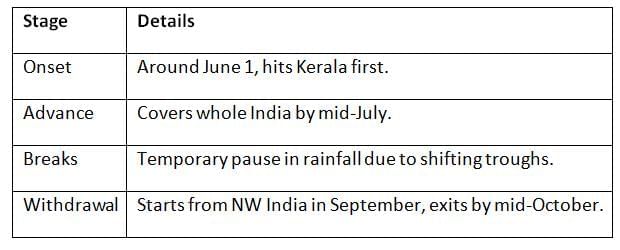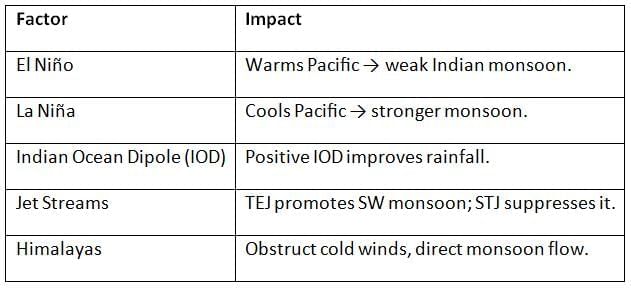UPSC Exam > UPSC Notes > Geography for UPSC CSE > Cheat Sheet: Indian Monsoon
Cheat Sheet: Indian Monsoon | Geography for UPSC CSE PDF Download
Meaning and Importance
- The term "monsoon" comes from the Arabic word "mausim", meaning season.
- It refers to the seasonal reversal of winds, bringing wet (summer) and dry (winter) seasons.
- It is the lifeline of Indian agriculture, economy, and ecosystems.
Mechanism of Indian Monsoon
- Differential Heating of Land and Sea – Creates low pressure over the Indian subcontinent and high pressure over the oceans.
- Shift of ITCZ – Inter-Tropical Convergence Zone moves northward over India in summer.
- Tibetan Plateau Heating – Becomes intensely hot, creating strong upper-air circulation.
- Subtropical Jet Stream (STJ) – Retreats north, replaced by the Tropical Easterly Jet (TEJ).
- Coriolis Force – Winds deflect to the right, turning southwest over India.
- Presence of Himalayas – Acts as a climatic barrier, trapping moisture-laden winds.
Types of Monsoon Winds

Branches of Southwest Monsoon
1. Arabian Sea Branch
- Hits Western Ghats → heavy orographic rainfall.
- Moves northwards along west coast (Kerala → Gujarat).
2. Bay of Bengal Branch
- Moves into NE India (Assam, Meghalaya).
- Deflected by Himalayas westward into Indo-Gangetic plain.
Onset and Withdrawal of Monsoon

Factors Influencing Monsoon

Abnormalities in Monsoon
- Monsoon Breaks – Intermittent dry periods during active monsoon.
- Delayed Onset or Withdrawal – Affects sowing and harvesting cycles.
- Uneven Distribution – Floods in one region, drought in another.
- Cyclonic Activity – Especially during retreating monsoon (e.g., Bay of Bengal cyclones).
Impact on Indian Economy
- 60% of agriculture is rain-fed → directly dependent on monsoon.
- Water availability for hydropower, drinking, and irrigation depends on monsoon.
- Monsoon determines food inflation, GDP growth, and rural employment.
Quick Facts
- Wettest place: Mawsynram (Meghalaya).
- Northeast Monsoon: Tamil Nadu gets ~50% of annual rainfall from it.
- IMD: Uses statistical and dynamical models to forecast monsoon.
The document Cheat Sheet: Indian Monsoon | Geography for UPSC CSE is a part of the UPSC Course Geography for UPSC CSE.
All you need of UPSC at this link: UPSC
|
175 videos|624 docs|192 tests
|
FAQs on Cheat Sheet: Indian Monsoon - Geography for UPSC CSE
| 1. What is the significance of the Indian monsoon in agriculture and the economy? |  |
Ans. The Indian monsoon is crucial for the country's agriculture as it provides approximately 70% of the annual rainfall. This rainfall is vital for the cultivation of various crops such as rice, wheat, and pulses. A good monsoon can lead to a bumper harvest, boosting the rural economy and ensuring food security. Conversely, a poor monsoon can result in droughts, crop failures, and economic instability, affecting millions of farmers and the overall economy.
| 2. How do monsoon winds operate and what mechanism drives the Indian monsoon? |  |
Ans. The Indian monsoon is primarily driven by the differential heating of land and sea, creating a pressure gradient. During the summer months, the Indian subcontinent heats up, leading to low pressure over land and high pressure over the Indian Ocean. This difference causes moist air from the ocean to flow towards the land, bringing heavy rainfall. The monsoon winds are influenced by the southwest trade winds and the Indian Ocean's warm waters, which further intensify the monsoon system.
| 3. What are the different branches of the southwest monsoon and their characteristics? |  |
Ans. The southwest monsoon has two main branches: the Arabian Sea branch and the Bay of Bengal branch. The Arabian Sea branch travels along the western coast of India, bringing heavy rainfall to states like Maharashtra and Gujarat. The Bay of Bengal branch moves northeast, causing significant rainfall in eastern India and the northeastern states. The interaction of these branches with the topography of the region leads to varied rainfall patterns across the country.
| 4. What factors influence the onset and withdrawal of the Indian monsoon? |  |
Ans. The onset of the Indian monsoon is influenced by several factors, including the temperature difference between the Indian landmass and the Indian Ocean, the position of the Intertropical Convergence Zone (ITCZ), and the presence of Western Disturbances. The withdrawal is determined by the retreat of the southwest winds and the establishment of high-pressure systems over the Indian subcontinent. The timing and duration of the monsoon can vary based on these atmospheric conditions.
| 5. What abnormalities can occur in the Indian monsoon and what impacts do they have? |  |
Ans. Abnormalities in the Indian monsoon include delayed onset, uneven distribution of rainfall, and excessive rainfall leading to floods. Such irregularities can cause severe agricultural impacts, including droughts in some regions and flooding in others. These conditions can disrupt food production, lead to economic losses, and affect water supply for drinking and irrigation, creating challenges for sustainable development and food security in the country.
Related Searches
















